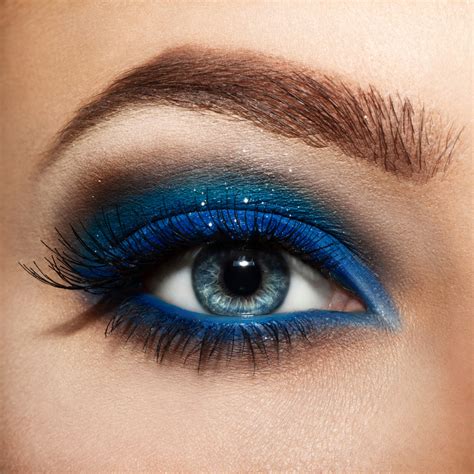
“And Azazel taught men to make swords, and daggers, and shields and breastplates. And he showed them the things after these (2v, a5) and the art of making them: bracelets, and ornaments, and the art of making up eyes and of beautifying the eyelids, and the most precious and choice stones, and all (kinds of) coloured dyes. And the world was changed. 8.2 And there was great impiety and much fornication, and they went astray, and all their ways became corrupt.”
1 Enoch 8:1-2
Let me start off by saying, I am not one of these puritanical, cosmetic-totalers who leaves the house every morning with a face full of acne, red splotches, and chapped lips thinking I am somehow doing my dogmatic duty and glorifying God by looking like death warmed over. This article is not decrying the atrocities of cosmetics, it is merely an exposé of their origins.
We are told plainly in the Book of Enoch 1 that cosmetics—specifically, the beautifying of the eyelids—was introduced to mankind via a rebellious Watcher, Azazel. It is interesting to me that we are told in Genesis 6:2 that even before the Watchers came to Earth, they found the women beautiful. So, why introduce cosmetics if these women were already attractive enough to forfeit their souls over?
The Bible does not forbid women from beautifying themselves—what it speaks against in 1 Peter is a godly woman’s beauty being merely external; and the Proverbs are rife with warnings against the adulterous woman who paints her eyes, dresses in scarlet, and is decked out in enough jewelry to make the 1980s blush.
The passage from Enoch 8 is telling in many ways:
- The cosmetic industry wasn’t started by Este Lauder—it was started by a rebellious fallen entity from the heavenly realm.
- The guy who introduced cosmetics to women, also introduced the art of weaponry and war to men.
- The result of women learning how to enhance their natural beauty with cosmetics directly resulted in “impiety and much fornication.“
Queue James 4:1—”What causes fights among you, is it not that your passions are at war among you? You desire and do not have, so you murder. You covet and cannot obtain, so you fight and quarrel.”
Sex and war always go hand in hand.
While the little ditty about Azazel isn’t specifically mentioned in the canonical Scriptures, there are plenty of other men of God who saw fit to write about the topic of painted eyes, including, but not limited to Peter, Solomon, Jeremiah, and Isaiah.
Proverbs 6:25
Don’t lust after her beauty in your heart, neither let her captivate you with her eyelids.
Jeremiah 4:30
And you, O desolate one, what do you mean that you dress in scarlet, that you adorn yourself with ornaments of gold, that you enlarge your eyes with paint? In vain you beautify yourself. Your lovers despise you; they seek your life.
2 Kings 9:30
When Jehu came to Jezreel, Jezebel heard of it. And she painted her eyes and adorned her head and looked out of the window.
Isaiah 3:16
The Lord said: Because the daughters of Zion are haughty and walk with outstretched necks, glancing wantonly with their eyes, mincing along as they go, tinkling with their feet, therefore the Lord will strike with a scab the heads of the daughters of Zion, and the Lord will lay bare their secret parts. In that day the Lord will take away the finery of the anklets, the headbands, and the crescents; the pendants, the bracelets, and the scarves; the headdresses, the armlets, the sashes, the perfume boxes, and the amulets.
We see clearly from these passages that the cosmetics, in and of themselves, are not what is evil—but the seduction, lust, and fornication that an abuse of them appear to often illicit. This means, women, not that we throw away all our makeup and leave the house looking like an unattractive frump—we are simply being warned to (1) not use our appearance to manipulate others or to cause them to sin, and to (2) put just as much, if not more, attention into the beautifying of our hearts as we do our faces.
The most convicting thing here, for me personally, is in whose eyes do I want to appear beautiful? Eligible men who might wish to marry me? My coworkers? My friend’s husband? Or do I want my beauty to be a biblically defined beauty that stirs the heart of Yahweh? Because we are told in Genesis that women without makeup and jewelry were beautiful in the sight of God, man, and heavenly beings. The makeup tricks Azazel taught our foremothers—all of which were passed down to us—were likely an attempt to make women beautiful in the eyes of these fallen spiritual entities. In other words, this cosmetically altered world was designed to seduce rebellious angels, not to attract God or godly eligible bachelors. Disobedient Watchers—is this who we are trying to impress? Is this who we want to emulate? Not likely!
David C. Pack, writing for “The Restored Church of God” writes:
“Even before its [cosmetics] use in Egypt, the original painted harlot was Semiramis, the mother-wife of Nimrod, and the founder of the Babylonian Mystery Religion. Semiramis is known as the mother of all harlots. She used makeup, as well as suggestive clothing, for various religious and sexual rituals. Along with various statues, paintings and busts still in existence from ancient times, descriptions show how Egyptians used cosmetics and revealing clothing to appeal to their sensuality. They adopted this dress into their culture from Semiramis, in an attempt to appear more like the many gods and goddesses they worshipped.”
So, here again, it’s not the purchase of, or even the application of cosmetics that is in and of itself wrong or sinful—it is the heart behind it. Who are we attempting to emulate? Whose image are we bearing when we pile it on thick or use certain eye-popping colors? What areas of our body are we attempting to draw attention too? Whose attention are we attempting to draw?
Interestingly, (and this might be fodder for a future Nefarious Fashion Trends article) there is much evidence that red lipstick and red clothing were historically linked specifically either to (1) royalty (who many times were of Nephilim bloodlines) or to (2) prostitutes.
In fact, the phrase “kiss of death” is a specific reference to a very particular kind of prostitute that would wear red lipstick—which acted as a marketing scheme to advertise her particular services. These prostitutes specialized in fallatio that often left them, and the men who hired them, fatally ill (or dead) from lead poisoning due to the lead-based lipstick worn by these harlots.
“Even as a child, I knew what I didn’t want. I didn’t want to wear red lipstick!”
Patti Smith
Common, respectable women of yesteryear never would have been caught dead (literally) donning the attire of prostitutes. It wasn’t until Hollywood came on the scene and reintroduced all of these long-forgotten fashion trends to the masses under the guise of women feeling “sexy and empowered” that many women were duped and lured in—unwittingly bearing the image of demons, goddesses, Nephilim queens, and prostitutes.




